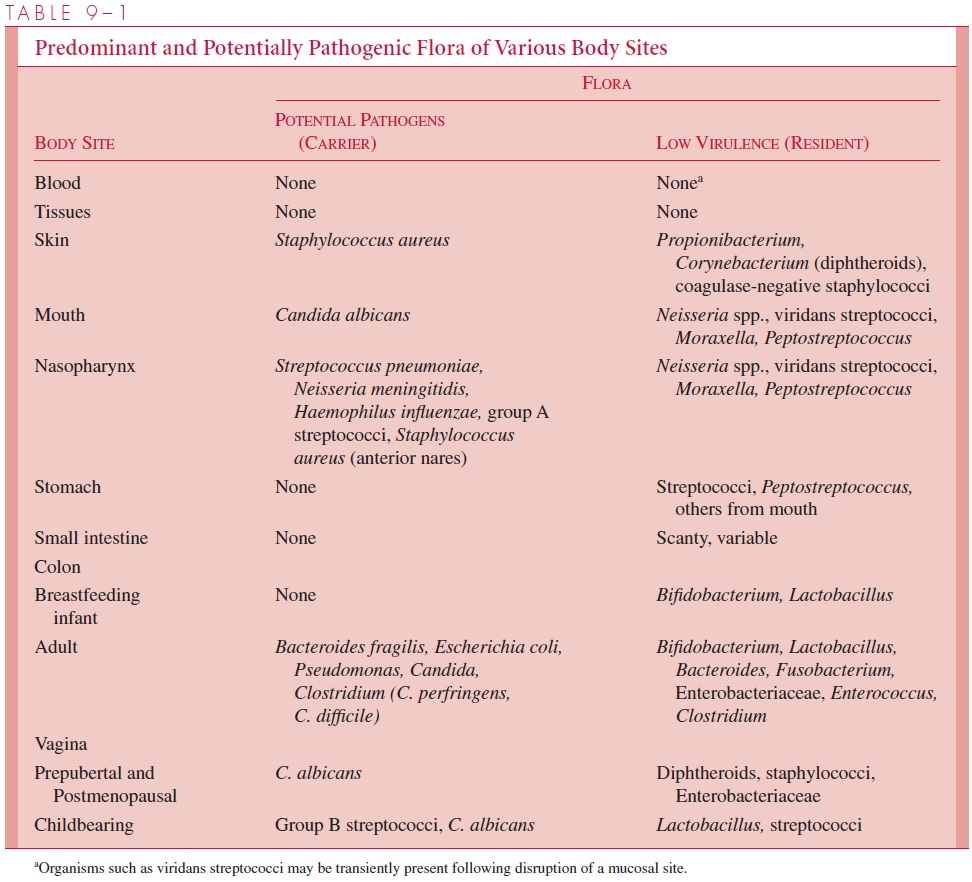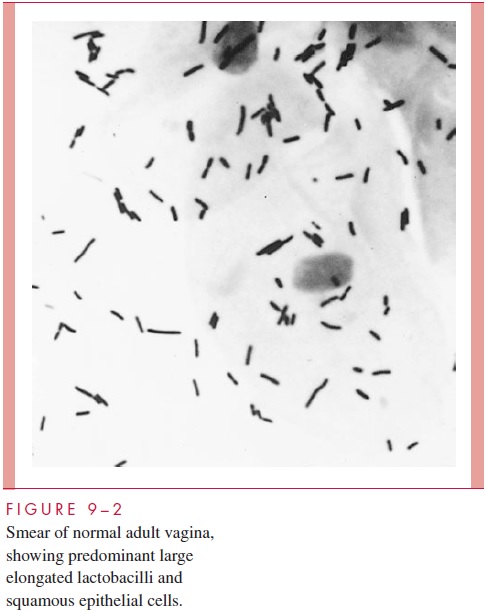Chapter: Medical Microbiology: An Introduction to Infectious Diseases: Normal Microbial Flora
Normal Flora at Different Sites
NORMAL FLORA AT DIFFERENT SITES
The total normal flora of the body probably contains more than 1000 distinct species of microorganisms. The major members known to be important in preventing or causing disease as well as those that may be confused with etiologic agents of local infections are summarized in Table 9 – 1, and most are described in greater detail in subsequent chap-ters. The student should not attempt to memorize unfamiliar names at this point.

Blood, Body Fluids, and Tissues
In health, the blood, body fluids, and tissues are sterile. Occasional organisms may be dis-placed across epithelial barriers as a result of trauma (including physiologic trauma such as heavy chewing) or during childbirth; they may be briefly recoverable from the bloodstream before they are filtered out in the pulmonary capillaries or removed by cells of the reticu-loendothelial system. Such transient bacteremia may be the source of infection when struc-tures such as damaged heart valves and foreign bodies (prostheses) are in the bloodstream.
Skin
The skin plays host to an abundant flora that varies somewhat according to the number and activity of sebaceous and sweat glands. The flora is most abundant on moist skin ar-eas (axillae, perineum, and between toes). Staphylococci and members of the genus Pro-pionibacterium occur all over the skin, and facultative diphtheroids (corynebacteria) arefound in moist areas. Propionibacteria are slim, anaerobic, or microaerophilic Gram-positive rods that grow in subsurface sebum and break down skin lipids to fatty acids. Thus, they are most numerous in the ducts of hair follicles and of the sebaceous glands that drain into them. Even with antiseptic scrubbing it is difficult to eliminate bacteria from skin sites, particularly those bearing pilosebaceous units. Organisms of the skin flora are resistant to the bactericidal effects of skin lipids and fatty acids, which inhibit or kill many extraneous bacteria. The conjunctivae have a very scanty flora derived from the skin flora. The low bacterial count is maintained by the high lysozyme content of lachry-mal secretions and by the flushing effect of tears.
Intestinal Tract
The mouth and pharynx contain large numbers of facultative and strict anaerobes. Different species of streptococci predominate on the buccal and tongue mucosa because of different specific adherence characteristics. Gram-negative diplococci of the genera Neisseria and Moraxella make up the balance of the most commonly isolated facultativeorganisms. Strict anaerobes and microaerophilic organisms of the oral cavity have their niches in the depths of the gingival crevices surrounding the teeth and in sites such as ton-sillar crypts, where anaerobic conditions can develop readily. Anaerobic members of the normal flora are major contributors to the etiology of dental caries and periodontal dis-ease .
The total number of organisms in the oral cavity is very high, and it varies from site to site. Saliva usually contains a mixed flora of about 108 organisms per milliliter, derived mostly from the various epithelial colonization sites. The stomach contains few, if any, resident organisms in health because of the lethal action of gastric hydrochloric acid and peptic enzymes on bacteria. The small intestine has a scanty resident flora, except in the lower ileum, where it begins to resemble that of the colon.

The colon carries the most prolific flora in the body (Fig 9 – 1). In the adult, feces are 25% or more bacteria by weight (about 1010 organisms per gram). More than 90% are anaerobes, predominantly members of the genera Bacteroides, Fusobacterium, Bifidobac-terium, and Clostridium. The remainder of the flora is composed of facultative organismssuch asEscherichia coli, enterococci, yeasts, and numerous other species. There are con-siderable differences in adult flora depending on the diet of the host. Those whose diets include substantial amounts of meat have more Bacteroides and other anaerobic Gram-negative rods in their stools than those on a predominantly vegetable or fish diet.
The fecal flora of breastfed infants differs from that of adults, with anaerobic Gram-positive rods of the genus Bifidobacterium constituting as much as 99% of the total. Hu-man milk is high in lactose and low in protein and phosphate, and its buffering capacity is poor compared with that of cow’s milk. These conditions select for bifidobacteria, which ferment lactose to yield acetic acid and grow optimally under the acidic conditions (pH 5 – 5.5) that they produce in the stool. Infants who are fed cow’s milk, which has a greater buffering capacity, tend to have less acidic stools and a flora more similar to that found in the colon of the weaned infant or the adult. These findings also apply to infants fed some artificial formulas.
Respiratory Tract
The external 1 cm of the anterior nares is lined with squamous epithelium. The nares have a flora similar to that of the skin except that it is the primary site of carriage of a pathogen,Staphylococcus aureus. About 25 to 30% of healthy people carry this organism as eitherresident or transient flora at any given time. The organism may spread to other skin sites or colonize the perineum; it can be disseminated by hand-to-nose contact, by desquamation of the epithelium, or by droplet spread during upper respiratory infection. The nasopharynx has a flora similar to that of the mouth; however, it is often the site of carriage of potentially pathogenic organisms such as pneumococci, meningococci, and Haemophilus species.
The respiratory tract below the level of the larynx is protected in health by the action of the epithelial cilia and by the movement of the mucociliary blanket; thus, only tran-sient inhaled organisms are encountered in the trachea and larger bronchi. The accessory sinuses are normally sterile and are protected in a similar fashion, as is the middle ear by the epithelium of the eustachian tubes.
Genitourinary Tract
The urinary tract is sterile in health above the distal 1 cm of the urethra, which has a scanty flora derived from the perineum. Thus, in health the urine in the bladder, ureters, and renal pelvis is sterile. The vagina has a flora that varies according to hormonal influences at dif-ferent ages. Before puberty and after menopause, it is mixed, nonspecific, relatively scanty, and contains organisms derived from the flora of the skin and colon. During the childbear-ing years, it is composed predominantly of anaerobic and microaerophilic members of the genus Lactobacillus, with smaller numbers of anaerobic Gram-negative rods, Gram-positive cocci, and yeasts that can survive under the acidic conditions produced by the lactobacilli. These conditions develop because glycogen is deposited in vaginal epithelial cells under the influence of estrogenic hormones and metabolized to lactic acid by lactobacilli. This process results in a vaginal pH of 4 to 5, which is optimal for growth and survival of the lactobacilli, but inhibits many other organisms. The consistency of the lactobacillary adult flora is seen in Gram-stained preparations of vaginal smears (Fig 9 – 2).

Related Topics